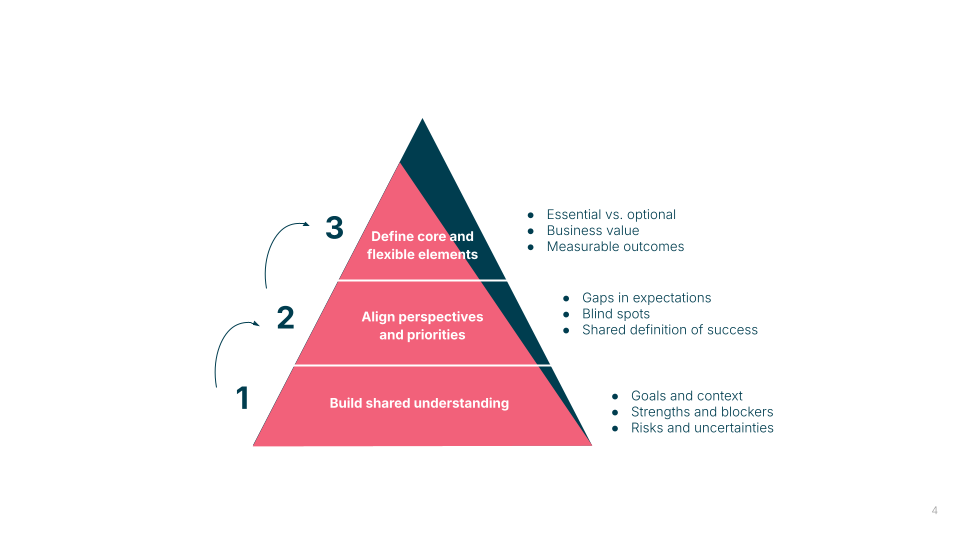When embarking on a complex strategic journey, like setting up a new operating model, launching a new service platform, reorganizing your tech teams to serve faster product cycles or enabling global support functions to deliver more consistent experiences across markets, it’s easy to get lost in the moving parts.
Too often, teams embarking on complex initiatives get caught up in the weeds, and lose track of their ultimate goals. What they need is a compass to keep them on track. This blog explores how to create such a compass, a framework that is meant to structure your thinking and action through ambiguity.
The business impact of a stalled strategic initiative
Before we get into how to keep your initiatives on track, it's important to understand the consequences of not doing so.
Organizations that fail to test and validate their new strategic efforts before scaling often encounter:
High failure rates in transformation efforts-studies suggest up to 70% of digital transformations fail due to a lack of alignment between strategy and execution.
Revenue leakage due to inefficient onboarding and decision-making processes.
At one client we worked with, we saw how a misaligned operating model led to a conversion rate of less than 40% during customer onboarding, causing substantial revenue loss during high market volatility.
Stalled product launches, delayed market entry and growth due to innovation bottlenecks, rigid approval and testing processes.
Where do we start when there’s no clear roadmap?
When teams are tasked with delivering a complex strategic initiative the stakes are high, the variables are many and alignment across functions doesn’t come automatically. In these moments, leaders and teams need more than a plan. They need a compass: a shared set of guiding questions to help them make sense of ambiguity, adapt their approach, and keep momentum.
These are the types of questions I use to orient myself when entering such terrain:
Where should we focus in the next few months to make tangible progress?
What roadblocks might slow us down, and how will we recognize a no-go decision early?
Should we revisit the strategic direction — or focus on making execution work?
These are not theoretical prompts. They reflect real dilemmas teams face on the ground. Whether you're building a new operating model, scaling an AI-driven service, or rethinking your customer support setup across regions — how you answer these questions determines whether strategy moves into action or stalls in planning mode.
Shaping the compass: a practical flow of guiding questions
Once you're engaged in a complex strategic initiative, you need to move quickly from broad ambition to shared understanding, structured alignment, and execution. Here's a simple and adaptable way to guide yourself and your team through that process, driven by the right questions at each step.
Below is a simple overview of the compass, a three-part flow to help you navigate complexity with clarity.


1. Build shared understanding of the initiative
Before any roadmap or operating model can take shape, you need to understand the strategic context, and make it visible to everyone involved. This starts with research, interviews, and collaborative sessions to extract insights and align perspectives.
Use guiding questions like:
What is this initiative really trying to achieve?
What are the top goals and strategic priorities?
What do people believe needs to happen for it to succeed?
What strengths, blockers, or knowledge gaps already exist in the team?
Where are the biggest uncertainties or risks?
How will we recognize progress or success?
How aligned are we on these points — really?
These questions aren’t for documentation, they’re for real conversations. The goal is to move from individual viewpoints to a shared, realistic understanding of what you’re taking on, what might get in the way and how you’ll know you’re on the right path.
2. Align perspectives inside your team and with stakeholders
Once you’ve gathered and set initial insights, through interviews, workshops, and internal discussions, you’ll likely notice gaps in understanding across different people or teams. This is normal: strategic initiatives often involve multiple stakeholders who each see part of the picture.
Now is the time to bring those perspectives together.
Focus on:
Surfacing mismatches in priorities or expectations.
For example: One team may be focused on speed-to-market, while another emphasizes risk mitigation. Both are valid — but they pull in different directions unless openly discussed.Identifying potential blind spots.
What’s being assumed without validation? Are there risks or blockers one group sees that others haven’t considered?Facilitating structured conversation to create shared understanding.
The goal isn’t to “align for alignment’s sake,” but to agree on what success looks like, what challenges lie ahead, and how to move forward together.
This shared understanding is what you’ll use to build your first working plan or roadmap.
After alignment, you’ll reach a point where it’s time to move from discussion to real-world testing. That means defining a first, testable version of the initiative, something tangible enough to validate with real teams or customers.
What I find very useful is to have a clear definition of what is core and what is optional. Not everything matters equally.
Within your team, list all elements that may be needed to test your initiative (might be a very long list at this stage).
Then ask:
Which elements are absolutely core, non-negotiable for success? If your list is running into double figures, your definition of non-negotiable probably needs revising.
Which elements are valuable, but flexible depending on resources, timing, or organizational readiness?
Your core elements should directly enable business impact. And should be aligned with your customers' needs.
Examples might include:
Clear roles and decision rights — Define who owns what, especially for decision-making and escalation.
Service catalog and team responsibilities — Clarify what’s offered, who consumes it, and where accountability sits.
Customer journey integration — Make sure your initiative supports real customer experiences like onboarding, support, or renewal.
Foundational metrics and feedback loops — Agree on three to four metrics that directly reflect success (e.g., cycle time, resolution rate, cost-to-serve).
Now ask:
✔️ Do these core elements contribute to measurable business value?
✔️ Are we focusing on what truly matters—or being pulled by organizational noise or short-term pressure?
No strategic initiative unfolds exactly as planned. But having a shared compass of questions — and using it consistently — keeps teams aligned and focused when things get complex. Whether you’re designing an operating model, scaling a new capability or transforming customer delivery, start with clarity, ask better questions, and revisit them as the journey evolves.
Disclaimer: The statements and opinions expressed in this article are those of the author(s) and do not necessarily reflect the positions of Thoughtworks.


















